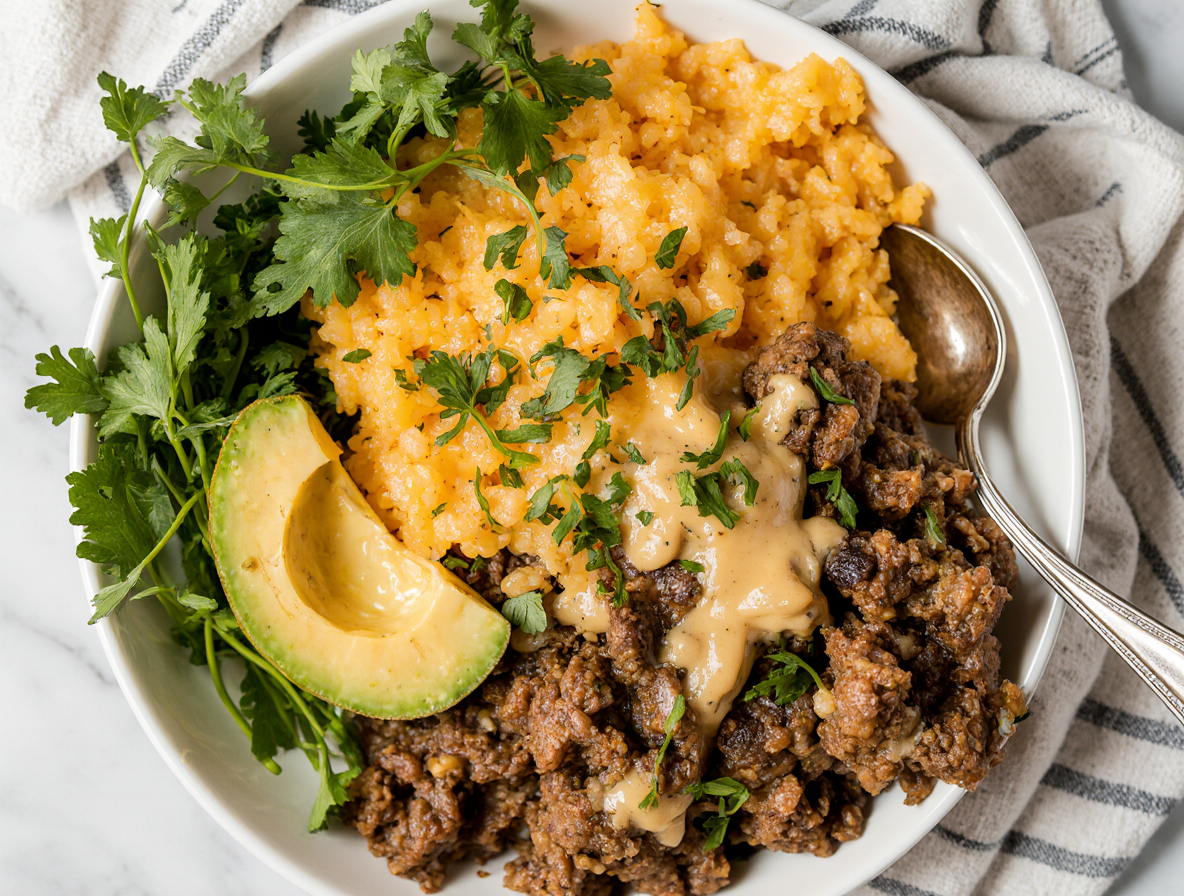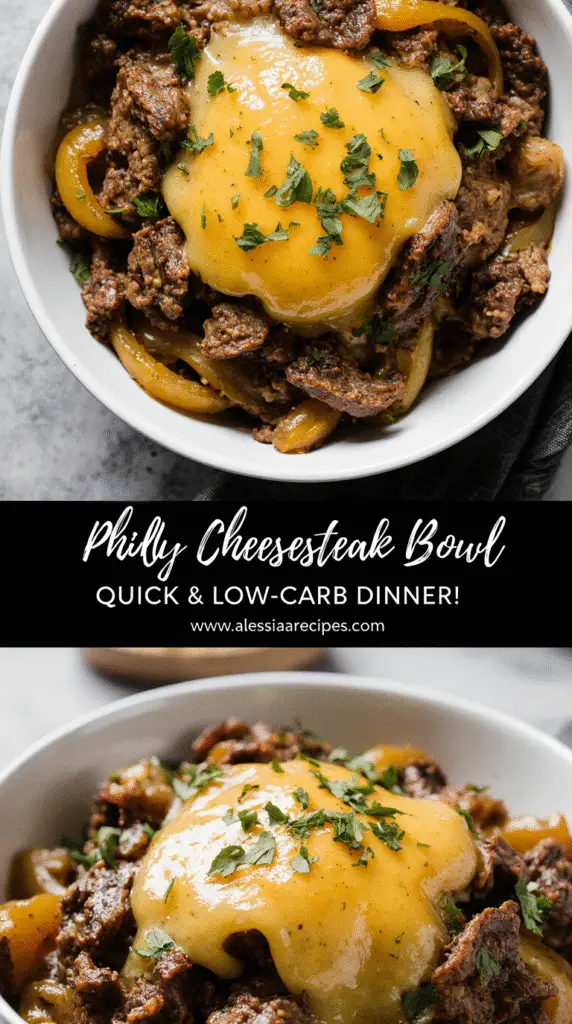How to Make Perfect Philly Cheesesteak Bowls: A 15-Minute Low-Carb Solution
Are you craving a delicious Philly cheesesteak bowls but don’t want to derail your healthy eating plan? We’ve got you covered! These protein-packed, veggie-loaded bowls are ready to eat in less than 20 minutes and require just one pan for minimal cleanup.
Not only are these low carb Philly cheesesteak bowls perfect for busy weeknights, but they’re also an excellent alternative to traditional carb-heavy sandwiches. In fact, they use ingredients you likely already have in your pantry, making them both convenient and budget-friendly. Plus, with grilled peppers, mushrooms, and onions as a base, you’re getting a hefty dose of vegetables without sacrificing the authentic cheesesteak flavor you love. Whether you’re following a keto lifestyle or simply looking for a healthy, high-protein meal option, these bowls deliver both nutrition and satisfaction in every bite.
Why Philly Cheesesteak Bowls Are the Perfect Low-Carb Meal
Philly cheesesteak bowls transform a classic sandwich into a nutrition powerhouse without sacrificing flavor. These satisfying meals have become increasingly popular for good reasons. Let me show you why they’re the perfect low-carb solution for busy people who want delicious, healthy food.
Quick to make in under 15 minutes
Preparing a complete meal in minutes might sound impossible, yet these cheesesteak bowls deliver exactly that promise. Most recipes come together in just 15 minutes, making them ideal for hectic weeknights when you’re tempted to order takeout.
The simplicity is part of their charm. Using a single skillet means minimal cleanup, and the straightforward cooking method doesn’t require culinary expertise. I simply:
- Brown the meat
- Sauté the vegetables
- Add cheese and assemble
Additionally, the ingredients are typically pantry staples you likely already have on hand. This means no special shopping trips or hunting for exotic components when you’re already hungry and short on time.
Naturally low in carbs and high in protein
The nutritional profile of these bowls is where they truly shine. While traditional cheesesteaks deliver flavor trapped between carb-heavy bread, these bowls offer all the taste with significantly fewer carbohydrates.
Most versions contain approximately 10-14g carbs per serving, making them suitable for various low-carb eating plans. Furthermore, these bowls pack an impressive protein punch—typically 29-47g per serving—which helps maintain muscle mass and promotes satiety.
From a calorie perspective, they’re remarkably reasonable. Depending on your specific ingredients, expect around 310-487 calories per serving[53], providing substantial nutrition without excessive energy intake.
Customizable for different diets
Perhaps the most compelling aspect of cheesesteak bowls is their incredible versatility. They easily adapt to virtually any dietary preference or restriction.
For keto enthusiasts, the already low-carb base can be modified by using cauliflower rice instead of regular rice. Those following paleo or Whole30 can substitute cashew cheese for dairy. Meanwhile, vegetarians might swap beef for mushrooms or plant-based protein.
The flexibility extends to protein choices as well. Though traditional recipes call for ribeye or shaved steak, you can easily substitute:
- Chicken breast for a leaner option
- Ground beef for budget-friendly meals
- Tofu for vegetarian versions
Even the vegetable components are adaptable—add broccoli, zucchini, or snap peas to boost the fiber content[51]. This adaptability ensures everyone at your table can enjoy a personalized version that aligns with their nutritional needs.
Essential Ingredients and Smart Substitutions
Creating perfect Philly cheesesteak bowls begins with selecting the right ingredients. The traditional sandwich components translate beautifully into a bowl format, yet knowing which options work best for low-carb eating makes all the difference.
Choosing the right cut of steak
Ribeye stands as the traditional choice for authentic Philly cheesesteaks, primarily because it’s well-marbled with fat that keeps it tender and flavorful when cooked quickly. For home cooking, however, several excellent alternatives exist:
- Sirloin: Leaner yet still tender, making it ideal for health-conscious eaters
- Flank steak: More affordable than ribeye while remaining tender when sliced properly
- Skirt steak: About half the cost of ribeye with a similar open-grained texture
The key technique? Slice your steak thinly against the grain. Partially freezing beef for about an hour before slicing helps achieve paper-thin cuts without specialized equipment.
Best cheese options for melting
Although cheese preferences spark heated debates even among Philadelphia natives, three options reign supreme:
- Provolone: Sharp and salty flavor that stands up to rich beef
- American cheese: Melts smoothly and offers mild flavor
- Cheez Whiz: Traditional option that creates the signature “cheese goo”
Low-carb veggie choices
The vegetable foundation of these bowls provides both flavor and nutritional value:
- Bell peppers (any color works) provide sweetness and crunch
- Onions (white or yellow) add essential aromatic flavor
- Mushrooms contribute meaty texture and umami depth
For extra customization, consider cauliflower rice as a base to make the bowl more substantial.
Dairy-free and vegan swaps
Dietary restrictions needn’t prevent anyone from enjoying this classic:
- Cashew-based cheese sauce: Combine raw cashews, lemon juice, nutritional yeast, and seasonings
- Vegan store-bought cheese: Look for provolone-style slices that melt well
- Plant-based “steak”: Options include seitan, soy curls, or even marinated tofu
Through thoughtful ingredient selection, your Philly cheesesteak bowls can satisfy cravings regardless of dietary preferences.
Step-by-Step: How to Make the Perfect Cheesesteak Bowl
Making your own delicious philly cheesesteak bowl at home is surprisingly straightforward. Let me walk you through the exact process I use to create this 15-minute meal that rivals any restaurant version.
1. Prep your ingredients
Initially, slice your steak as thinly as possible—partially freezing it for 20-30 minutes makes this task much easier. For a proper cheesesteak texture, chop the sliced beef into small ¼-inch pieces. Next, dice your bell peppers, onions, and mushrooms into bite-sized pieces. If using seasonings, combine salt, pepper, paprika, chili powder, onion powder, garlic powder, thyme, marjoram, and basil in a small bowl.
2. Sauté veggies for flavor
Heat oil in a large skillet over medium heat. Add your peppers and onions first, cooking until tender but not browned. This typically takes about 10 minutes. Afterward, add mushrooms and garlic, continuing to cook until everything is softened. Remember these aren’t fully caramelized onions—they should retain some texture and bite.
3. Cook steak to your liking
Once veggies are tender, transfer them to a plate. Return the same pan to medium-high heat with a touch more oil. Add your thinly sliced beef, cooking quickly for just 4-5 minutes until no pink remains. Season with Worcestershire sauce and your spice blend during cooking.
4. Add cheese and let it melt
Prior to completing the cooking process, place provolone slices over the meat mixture. For the authentic cheesesteak experience, use half your cheese stirred into the meat until fully melted, then layer remaining slices on top. Cover the pan and remove from heat, allowing residual warmth to melt the cheese completely.
5. Assemble your bowl
Finally, choose your preferred base:
- Cauliflower rice for ultra-low-carb option
- Mixed greens for added nutrients
- Simply as-is for traditional experience
Divide your veggie mixture between bowls, top with the cheesy meat mixture, then finish with optional garnishes like green onions.
Serving, Storing, and Meal Prep Tips
These versatile philly cheesesteak bowls offer multiple serving options and excel as meal prep champions. Once you’ve mastered the cooking process, knowing how to serve and store them properly ensures you’ll enjoy this delicious meal throughout the week.
Best bases: cauliflower rice, greens, or as-is
Philly cheesesteak bowls adapt perfectly to various dietary needs. For those maintaining a strict low-carb lifestyle, cauliflower rice provides an excellent foundation that adds volume without significant carbs. Alternatively, crispy romaine lettuce creates a refreshing salad-style presentation that boosts your vegetable intake. Moreover, many keto enthusiasts enjoy these bowls exactly as prepared—the protein and veggie mixture stands perfectly well on its own. For family members not following low-carb plans, white or brown rice offers a more filling option.
How to store leftovers properly
After cooking, allow your philly cheesesteak bowls to cool completely to room temperature before storing. Subsequently, transfer portions into airtight containers and refrigerate promptly. Properly stored leftovers remain fresh for 4-5 days, making them perfect for weekly meal prep. For optimal freshness, separate components if possible—keeping meat and vegetables apart from any fresh garnishes until serving time.
Freezing and reheating instructions
Essentially, these bowls freeze beautifully for longer storage. After cooling completely, place portions in freezer-safe containers or ziplock bags for up to 3 months. For best results, thaw frozen meals overnight in the refrigerator. When reheating, microwave for approximately 2 minutes, adding a teaspoon of water and covering to prevent drying out. Consequently, you’ll have delicious emergency meals ready whenever hunger strikes.
Conclusion
Philly cheesesteak bowls truly stand out as a perfect solution for anyone wanting to enjoy classic flavors without the carb overload. Throughout this guide, you’ve seen how these delicious bowls transform a beloved sandwich into a nutritional powerhouse while still delivering that authentic taste you crave.
What makes these bowls especially appealing is their incredible versatility. Whether you follow keto, paleo, or simply want a protein-rich meal, these bowls adapt to your specific needs. Additionally, the quick 15-minute preparation time makes them ideal for busy weeknights when cooking elaborate meals seems impossible.
Remember, the perfect cheesesteak bowl starts with quality ingredients. Thinly sliced ribeye or sirloin steak, properly melted cheese, and fresh vegetables create that unmistakable Philly experience. Still, feel free to experiment with substitutions based on your dietary preferences or what’s available in your kitchen.
Perhaps most importantly, these bowls solve the common dilemma between eating healthfully and enjoying satisfying comfort food. You can now have both without compromise. The single-pan cooking method also means less time cleaning up and more time enjoying your meal.
These bowls work wonderfully as meal prep options too. After trying them once, consider making a larger batch to enjoy throughout your week. Properly stored, they’ll maintain their flavor and texture for several days, providing quick, nutritious meals whenever hunger strikes.
Next time a cheesesteak craving hits, skip the carb-heavy sandwich and try this bowl version instead. Your taste buds will thank you for the familiar flavors, while your body will appreciate the protein boost and vegetable intake. Undoubtedly, these Philly cheesesteak bowls deserve a regular spot in your meal rotation for both their taste and health benefits.
FAQs
Q1. How long does it take to make Philly Cheesesteak Bowls? These delicious bowls can be prepared in just 15 minutes, making them perfect for busy weeknights or quick meals.
Q2. Are Philly Cheesesteak Bowls suitable for a low-carb diet? Yes, they are naturally low in carbs, containing only 10-14g per serving, while being high in protein with 29-47g per serving, making them ideal for low-carb diets.
Q3. What’s the best cut of steak to use for Philly Cheesesteak Bowls? While ribeye is traditional, sirloin, flank steak, or skirt steak are excellent alternatives that are more affordable and still provide great flavor and tenderness.
Q4. Can I make Philly Cheesesteak Bowls dairy-free or vegan? Absolutely! You can use cashew-based cheese sauce or vegan store-bought cheese alternatives. For a vegan “steak,” options include seitan, soy curls, or marinated tofu.
Q5. How long can I store leftover Philly Cheesesteak Bowls? When stored properly in airtight containers in the refrigerator, leftovers can stay fresh for 4-5 days. They can also be frozen for up to 3 months for longer storage.


